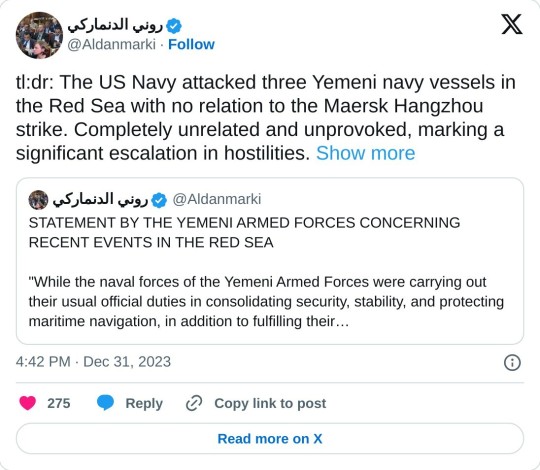#regional economy
Text

[CONT] call, prompting aircraft carrier USS Dwight D. Eisenhower to come to its aid, dispatching helicopters to deal with approaching Yemeni Navy vessels





If the US and the UK go through with this plan, the Yemenis will bomb oilfields across the Gulf. This is will increase global oil prices significantly and ultimately tanking the global economy. If you thought life is hard now, you're not ready for how bad things will get in 2024.
All Joe Biden has to do to stop the Red Sea blockade is lift the siege on Gaza.
#yemen#jerusalem#tel aviv#current events#palestine#free palestine#gaza#free gaza#news on gaza#palestine news#news update#war news#war on gaza#regional war#global economy#at the very least this will continue to turn the world against israel and america
2K notes
·
View notes
Text
We want to make something that already exists more climate-friendly

Despite climate change in favour of the indoor ice rink - or because of that? A dispute has broken out over the construction of the leisure facility in Fürstenfeldbruck. City councillor Alexa Zierl of the Oekologisch-Demokratische Partei explains why she thinks it is justifiable.
Alexa Zierl, 53, has been the consultant for climate protection and energy on the city council of Fürstenfeldbruck[1] since May 2014 and still supports the construction of an indoor ice rink. She studied electrical engineering and information technology, made her PhD in the field of robotics, was responsible for technical communication in a Munich software company for eleven years and became self-employed in 2011 in the field of climate protection. Zierl created the first climate action plan for the city of Fürstenfeldbruck, headed the Ziel 21 energy transition association[2] for four years and has been Bruck's first bicycle taxi driver since 2017. With the cargo bike she is active with the food rescuers and delivers food for the Caritas Hofcafé[3]. Her family of four lives in Fürstenfeldbruck without a car. In the interview, she also responds to Theresa Hannig, who rejects the construction of the indoor ice rink[4].
The district ÖDP[5] is against building apartments on Kreuzlinger Feld in Germering, but you are in favour of an ice rink in Fürstenfeldbruck. How does that fit together?
Alexa Zierl: As the name suggests, there would be buildings on a field at Kreuzlinger Feld, which would disrupt the supply of cold air to Germering in summer. In Bruck, we want to convert the sealed area of the ice stadium into an ice rink, generate more renewable electricity on the new roof than is needed and use the waste heat from the ice technology to save heating energy in the indoor pool, i.e. make something that already exists climate-friendly.
You say you are supporting the construction of the ice rink because of climate change. Can you explain that?
What do we want to preserve for the future? I think that children and young people should have simple and inexpensive sports and leisure activities locally all year round, where they can meet and do something together. The ice rink is such an offer for all age groups, but is already less and less usable today due to the weather and the climate. An ice rink can be used for ice skating from autumn to spring and for something else the rest of the year, even when it is raining or hot, for example roller skating, an indoor playground or climbing.
Were you surprised by the criticism of your attitude?
I was surprised that people argued against ice sports with climate protection, but voted in favour of dedicating arable land to commercial areas a few weeks earlier.
They say we will drown in renewable electricity. When might that be the case?
Currently, almost half of the electricity consumed in Germany each year comes from renewable sources, and there are days every month when more renewable electricity is generated than is needed. The federal government intends to double renewable electricity production by 2028. Then we will have many days when we have much more renewable electricity than we need. For those who find this inconceivable: the earth "bathes" day after day in a huge amount of free solar energy, which also produces free wind. With photovoltaics (PV), solar thermal energy and wind turbines, we imitate the plants and collect this energy. This is much easier and now cheaper than digging up and burning coal, oil or natural gas.
Do we still have time to develop this? Climate change is progressing faster than feared. Don't radical measures really need to be taken?
When it comes to renewable energies, all bureaucratic brakes really have to be removed - abolition of the 10H rule[6] in Bavaria, return to cost-covering remuneration, grid connection and feed-in guarantee. The installation of photovoltaic (PV) systems on and at buildings must become completely unbureaucratic. This time in favour of the electricity sector. It is also important to change course in construction, domestic flights, climate-damaging subsidies and animal husbandry/agriculture. Unfortunately I haven't seen any of that yet.
Wind turbines and solar systems have to be built first, which requires building materials such as metals and cement, that sometimes have to be mined or produced, which sometimes involves a great deal of energy. To what extent is this included in your calculation?
Why do you ask that about wind and solar and not about the construction of buildings or roads, for example when the district office is adding a concrete parking deck? We have to get out of fossil fuels as quickly as possible, that can only be done with renewable energies. It is therefore necessary to provide the necessary material for PV, wind power & Co. and conversely to "save" on other projects. Of course, renewable energy systems must be fully recyclable.
Wouldn't it be more clever if you only built as many renewable energy systems as you need for the areas that are really necessary?²
Who decides what is "really necessary"? With Corona, we saw that savings are first made among target groups like children and young people. As I said, the earth bathes in free solar energy, let's just catch it on and in all buildings with PV. This also helps those rent their house or apartment, because it reduces electricity costs. And solar thermal saves natural gas.
If not the ice rink, what do you think could be dispensed with?
Devices in standby should be switched off "properly". For comparison: the Burgau ice rink has 40,000 guests a year and consumes 300,000 kilowatt hours, i.e. 7.5 kilowatt hours per guest. In order to save these 7.5 kWh, the guests would only have to switch off one device at home that uses one watt in standby (old devices need significantly more), really switch them off instead of standby. What brings even more: train instead of domestic flight, electric instead of combustion engine, eat grain yourself instead of feeding animals to eat them.
Haven't we actually reached a point where politicians should honestly say that winter sports will not be possible for much longer?
Outdoor winter sports (skiing, etc.) currently need artificial snow, which means a lot of energy and water, not to mention driving in a car, that's not sustainable - which I personally think is a shame. I like to ski, I can't ice skate, and I wouldn't exist without skis, my parents met on a skiing holiday. On the other hand, ice sports in a hall in winter is energetically much cheaper than going to an indoor pool or even a sauna, also because - see the back of the refrigerator - the generation of cold produces waste heat that can be used to save heating energy.
How do you feel about the concept of a post-growth policy, which the ÖDP also represents, and where do you see concrete starting points in Fürstenfeldbruck?
One of the reasons why I became member of the ÖDP in 2019 is that it is the only party that sees economic growth not as a solution but as a problem. What the ÖDP proposes as alternatives: focus on the common good, regional economies, local energy supply in the hands of citizens, circular economy, short distances, using areas multiple times instead of expanding more and more. For me, the ice rink is a contribution to post-growth, because you use an already sealed area more intelligently and thus take the pressure off the Alpine region.
What gives you hope that we can still keep the earth habitable for humans?
It can only work if at some point we see ourselves worldwide and together with nature as a dwelling and living community on our planet. Currently, human civilization resembles an aggressive form of Compulsive hoarding[7]. But the many daily experiences where people work for the common good give me hope.
Source
Ingrid Hügenell, "Wir wollen etwas Bestehendes klimafreundlicher machen", interview mit Stadträtin Alexa Zierl, in: Süddeutsche Zeitung, 11-08-2022, https://sz.de/1.5637839
[1] Fürstenfeldbruck is a town in Bavaria, Germany, located 32 kilometres west of Munich. It is the capital of the district of Fürstenfeldbruck. As of 2004 it has a population of 35,494. Since the 1930s, Fürstenfeldbruck has had an air force base. The name of Fürstenfeldbruck is composed of two parts, namely 'Bruck', Bavarian dialect for 'bridge' (meaning the bridge over the Amper river) and after the famous monastery of Fürstenfeld Abbey.
[2] ZIEL 21 (=TARGET 21) on the way to an energy agency. A few years ago, we at ZIEL 21 set out to convert the ZIEL 21 association into an energy agency. After the first talks with Hans Gröbmayr (Energy Agency Ebersberg/Munich) and Ludwig Friedl (CEO Bavarian Energy Agency), we were asked to include the districts of Landsberg, Starnberg and Dachau in our considerations. We are now immediately faced with a decision as to whether we will set up a joint energy agency for FFB, LL and STA counties. Since many questions have to be clarified in this implementation process, we, the energy transition associations, met with Hans Gröbmayr again
[3] The hofcafé is a lunchtime restaurant and café in the heart of Fürstenfeldbruck. We offer our guests seasonal, freshly prepared dishes - vegetarian, vegan or with meat, cold drinks, tea and coffee specialties and homemade cakes. Every Friday we serve a classic and a vegetarian breakfast. https://www.caritas-nah-am-naechsten.de/caritas-zentrum-fuerstenfeldbruck/cont/38614
[4] A new ice rink is to be built in Fürstenfeldbruck near Munich - city councilor Theresa Hannig rejects this. A conversation about climate change and privilege we forgot was privilege. https://www.sueddeutsche.de/muenchen/fuerstenfeldbruck/fuerstenfeldbruck-eishalle-theresa-hannig-klimawandel-1.5628135?reduced=true
[5] Oekologisch-Demokratische Partei – Germany’s Green Party
[6] The 10H regulation of the Bavarian building regulations (BayBO, Article 82) is a minimum distance regulation between wind turbines and settlements.
[7] Compulsive hoarding, also known as hoarding disorder, is a mental disorder characterised by accumulation of possessions due to excessive acquisition of or difficulty discarding them, regardless of their actual value, leading to clinically significant distress or impairment in personal, family, social, educational, occupational or other important areas of functioning. Excessive acquisition is characterized by repetitive urges or behaviours related to amassing or buying items. Difficulty discarding possessions is characterized by a perceived need to save items and distress associated with discarding them. Accumulation of possessions results in living spaces becoming cluttered to the point that their use or safety is compromised.
0 notes
Link
70 notes
·
View notes
Text
Every region is responsible for its own currency but all international trade is conducted with the yen.
29 notes
·
View notes
Text
in my 'halo species as star wars species' au the kig yar have a very 'casual' relationship with force sensitivity in their culture; there are a large variety of jobs that require the skillset of any general force user, though those with highly developed precognition or psychometry were considered especially valuable in exploration and evaluation. there is also a special sect of kig yar who tune all of their senses into the force until their perception transcends that of all other known species. they produce the greatest and deadliest sharpshooters in the galaxy.
#halo fans know Exactly what i mean#also in star wars kig yar are less pirates and more explorers#they chart stars and hyperspace routes and the unknown regions#they investigate planets and map systems#a large chunk of their economy revolves around the data they sell#the sw galaxy is big so resources are constantly in demand#halo (star) wars
24 notes
·
View notes
Link
I posted a video yesterday that explains why smaller banks in the US are under strain and threat. This article continues with that line, and goes deeper into how this will affect the US economy going down the road. Things don’t look good.
8 notes
·
View notes
Text
Spikemuth Economic Revival
In response to Epicspheal, concerning Spikemuth’s economy.
Spikemuth may be able to diversify its economy beyond Piers’ Gym and concerts by the development of renewable energy and high-value specialty horticultured products. Minor tourism increases and manufacture of electronics are also options.
---
Renewable Energy City
Given Spikemuth has a small, densely-built, partly-enclosed population, it would be relatively easy to reconfigure it into a model environmentally-friendly city, if perhaps only at the pilot scale.
It seems Spikemuth is based on Llanduno, Wales. If true, then it may have significant wind power potential, as Llandudno is a prospective wind power development site. In real life, the offshore wind farm off Llandudno was resisted due to its anticipated effect on reducing the natural beauty of the landscape, thus affecting the tourism industry. Spikemuth, however, doesn't seem to have a tourism industry to protect. Notably, other than the power generation in Hammerlocke (probably based on Galar particles: it's not specified in-game), Galar doesn't seem to have any power plants. Hammerlocke's power plant might be facing bad public relations since the Eternatus incident, so if Spikemuth loaned out land in Outer Spikemuth (Route 9 next to Spikemuth) to wind power development, it would be a tremendous opportunity to diversify Galar's energy production.
Spikemuth's houses are all very close together, so upgrading its electrical transmission would require fewer materials. On the other hand, they are crammed so close together that there's less operating space, so homes might need substantial drilling or remodeling to install new cables, if the internal systems need upgrading.
Spikemuth's dense population, limited walking space, and crowd of people attending Piers' concerts could also make it useful for pilot studies of piezoelectric panels, like the Watt Nightclub in the Netherlands. Whether this would be viable as anything but a mildly tourist-attracting novelty depends on the Pokemon world's technology. Most likely, it would be a supplemental source of energy to keep the lights on if there's a problem with the wind turbines for a few days (barring excellent energy storage), or simply to emphasize Spikemuth as an town of renewable energy.
Specialty Agriculture
The fact the whole city is enclosed could also make it potentially useful for growing flowers sensitive to cold temperatures, although the market for this would be limited and subject to competition from better-prepared areas. To optimize this use, Spikemuth's roof would also have to be replaced with glass, or some other transparent material. Perhaps a more valuable and distinctive product is taking advantage of Spikemuth's dim environment to grow high-value blanched vegetables, such as white asparagus, and blanched cardoon, endive, leeks, and sea kale. Spikemuth's enclosed, dim, controlled conditions could be useful for growing mushrooms, and the existence of mushrooms as a camping ingredient suggests there's some market for it. Paras's tochukaso is evidently very valuable, and Paras tend to live in low-light environments or caves, so if Spikemuth can import Paras, it could cultivate tochukaso.
Minor Uses
Spikemuth is built as if it was originally a massive warehouse: it has thick walls around it and a roof. Theoretically, it could be retrofitted into a small indoor city: a novelty in the winter. Alternatively, the stabler weather conditions inside the city itself could provide plenty of room to create electronics sensitive to dust or fluctuations in temperature. They would have clean rooms, of course, and decotamination foyers, but the enclosure of the city itself could provide an additional layer of protecton.
Combination:
Spikemuth could, of course, reconfigure itself into a renewable power town using wind power and piezoelectric paneling, and then use that energy to optimize its specialty agriculture, or perhaps to rapidly dry, freeze, or package products for shipping. Circhester, one of the closest towns, might particularly appreciate fresh vegetables: Circhester is so cold it’s apparently covered in perpetual snow, which would limit the types of vegetables it can grow and how effectively it can grow them.
#Pokemon#Meta#Analysis#Pokemon Worldbuilding#Pokemon Economy#Pokemon World Economy#Galar Region#Spikemuth#Pokemon Sword & Shield#Agriculture#Horticulture
39 notes
·
View notes
Link
13 notes
·
View notes
Text
This community in southern Mexico has defied the gender binary for generations | CNN
Editor’s Note: CNN Original Series “Eva Longoria: Searching for Mexico” airs on CNN Sundays at 9 p.m. ET/PT. Sign up to CNN Travel’s four-part Unlocking Mexico newsletter for more on the country and its cuisine.
CNN
—
In the town of Juchitán de Zaragoza, located on the Isthmus of Tehuantepec in Mexico’s southern state of Oaxaca, one variation of a local legend goes something like this.
San…

View On WordPress
#Business#business and industry sectors#clothing and accessories#consumer products#continents and regions#domestic alerts#domestic-international news#economy and trade#iab-style & fashion#latin america#mexico#north america#sex and gender#society#the americas#transgender persons
5 notes
·
View notes
Text
Putin to chair Russia Security Council meeting after humiliating explosion on strategic Crimea bridge | CNN
Putin to chair Russia Security Council meeting after humiliating explosion on strategic Crimea bridge | CNN
CNN
—
Russian President Vladimir Putin will hold an operational meeting of his Security Council on Monday, just two days after a massive explosion on a key strategic bridge linking Crimea and Russia.
The meeting itself isn’t out of the ordinary – Putin regularly holds operational meetings with the Security Council, usually on a weekly basis, according to TASS. However, it comes just days…

View On WordPress
#accidents#business#business and industry sectors#conflicts and war#continents and regions#crimea#disasters and safety#eastern europe#economy and trade#europe#explosions#government and public administration#government bodies and offices#local governments#military#military weapons#political figures - intl#roads and traffic#Russia#russia-ukraine conflict#transportation and warehousing#transportation infrastructure#Ukraine#unrest#Vladimir Putin#weapons and arms
10 notes
·
View notes
Link
“Targeting”, a term which here does NOT mean “reaching out to”.
5 notes
·
View notes
Text
ok i'm actually really enjoying suzerain so far. i was a bit wary about the management aspect of it, but it's not a timed game which is usually what makes me anxious, it's completely text-based and you get all the time you need to make your decisions. basically read and decide, and i can do those just fine.
sure, maybe the decisions i'm making are the worst decisions you could probably make and i'm dooming this country little by little, but hey! i'm having fun so that's all that matters, yippee!
#listen i know that better infrastructure in already developed regions will give the economy a boost#but i think the poor people in the other side of the country deserve to have roads. just my two cents. sue me.#this is very fun i will not last one term tho. fun.#jules plays suzerain
2 notes
·
View notes
Text
Tourists held by Peruvian indigenous group protesting oil spill are freed, says official | CNN
Tourists held by Peruvian indigenous group protesting oil spill are freed, says official | CNN
CNN
—
A group of tourists traveling in the Peruvian Amazon, who were detained on Thursday by an indigenous community demanding government action over an oil spill, were freed on Friday, according to Abel Chiroque, head of the ombudsman office in Loreto.
Chiroque told CNN on Friday that 140 travelers in total were released.
Earlier, Wadson Trujillo, leader of the Cuninico community, confirmed…

View On WordPress
#accidents#business#business and industry sectors#continents and regions#disasters and safety#economy and trade#energy and environment#energy and utilities#environment and natural resources#Latin America#oil and gas industry#oil spills#Peru#South America#the americas#tourism#travel and tourism
5 notes
·
View notes
Text

page 559 - flag of popular Economian region.
These are lame as hell. Also, I think they HAVE been gassing me from time to time, knocking me out. To reset the blog or whatever, I do not know. I think the other guy took the gas this time though. As in the gas started and I held my breath and pinched my nose and my eyes stung and watered, then from across the room I heard wild hyper-ventilating. But it was slow. The most intense deep breaths you've ever heard, trying to draw all the air in this dungeon across to him. It's like he was trying to pull the gas away from me. Am I down here with a hero? A breath hero?
#economics#economy#economists#capitalism#vexillography#vexillum#vexillology#semaphore#semaphor#flag#flags#region#regional#state#state flags#history of economia#economia#flags of economia#tourism economia#tourism#guide#guidebook#dungeon life#dungeon#laughing gas#ai#ai art#ai generated#part ix#national and international equilibrium
5 notes
·
View notes
Text
Jetez un œil à cette histoire que j'ai sauvegardée sur Pocket
https://www.geo.fr/geopolitique/diagonale-du-vide-une-carte-devoile-les-zones-de-france-inhabitees-213414?utm_source=pocket_mylist
Le Grand Est c'est les meilleurs !
Filles de l'Est, fils de l'Est... C'est très nature. C'est très mature.
2 notes
·
View notes
Text
So You Want to Buy a Togepi: Estimated Minimum Import Costs for Pokémon

In this article, you’ll learn how the following relate to buying a Togepi:
• The price of a used 2001 Honda Civic in 2005
• The legality of buying Pokémon and legal loopholes
• Shipping cost per mile between Japan and Baja California
• How much it costs to import rice crackers from Japan into Manhattan
• Swedish tax rate income deductions
• How much an 11-year-old is paid to throw 2.6 pounds
• Recommended percentage of income for discretionary spending
• The average wage of a construction worker in the U.S. in 2005
• Unexpectedly athletic obese people
Introduction
But, somewhere along the line in this story, someone probably bought a Togepi.
And how much did that someone pay?
Caveats
The following will assume there are not dedicated breeding operations for Pokémon for export to Orre, and will not be considering monetary inflation in the Pokémon world. These are all rough calculations.
Some Trainers probably too young for a job have Togepi. These can be presumed to be gifts, or a suggestion that the labor cost of obtaining Togepi is lower than calculated. As it is impossible for the player to breed a Pokémon in Pokémon XD, it is unclear whether there are breeding operations in Orre.
Base Labor Cost
The price of chucking six Pyukumuku back into the ocean is 20,000 P2, or, logically, ~3,333 P per Pyukumuku. Notably, one also has to find them, not just chuck them, so there's a search cost involved.
Pyukumuku weighs 2.6 pounds. A baseball, which will be used as a proxy for a Poke Ball, weighs about 5 ounces. There are 41.6 ounces in 2.6 pounds, so it would be, very roughly, 8.32 times harder to throw a Pyukumuku into the ocean than to throw a Poke Ball the same distance. So the labor cost of finding a Pokémon and throwing a single Poke Ball is, at minimum, roughly 401 P (or 400.6 P not rounded up) which converts to $3.14. The material cost of a single Poke Ball is 200 P ($1.56), so the total minimum capture cost would be roughly 601 P, or $4.70.
But, if all one is doing is throwing, not battling, one would want a stronger Poke Ball: an Ultra Ball, for example. That's 1,200 P in Johto and Kanto (outside of Let's Go Pikachu and Let's Go Eevee), so the equivalent of $9.39.
Therefore, the minimum cost of obtaining a Togepi from the wild would be about 601 P ($4.70) if using one Poke Ball with a lucky shot, or to 1,601 P ($12.53) if using an Ultra Ball.
Cost Checking
With the exception of the Magikarp salesman, who’s a con artist, it is not generally legal to buy Pokémon directly. It is, however, possible to buy coins at Game Corners and use those coins to buy Pokémon. The coin conversation value is 50 coins per 1000 P, so 1 Coin is Worth 20 Pokédollars. Pokédollars are based on yen. Therefore, the coin cost of Pokémon sold indirectly through Game Corners can provide a rough proxy of the market prices.
Celadon Game Corner Prizes (as of Generation III Abra = 180 C (3,600 P/$28.18)
Clefairy = 500 C (10,000 P/$78.27)
Dratini = 2800 C (56,000 P, $438.31)
Scyther = 5500 C (110,000 P, $860.97)
Porygon = 9999 C (199,980 P, $1,565.24)
Note: they're all different levels, which makes it hard to figure out their prices if they were equivalent levels.
These prices make sense, as they correspond to the Pokémon being increasingly hard to find and catch.
Abra: Found in two routes; encounter rate of 15%; hard to catch because it uses Teleport, although multiple strategies can reduce this risk or eliminate it entirely. It's possible to combine Ultra Balls with other trapping strategies, so it's not that hard to catch if one's prepared.
Clefairy: Found only in Mt. Moon; low encounter rate of 1-6%. Unlike Abra, it doesn't require unusual techniques, though it is harder to find.
Dratini: Only in the Safari Zone, can't be legitimately obtained by battling; can't use Ultra Balls; low encounter rate (15%), high base flee rate (35%).
Scyther: Only in the Safari Zone, can't be legitimately obtained by battling; can't use Ultra Balls; low encounter rate (4%); high base flee rate (45%). limited number of steps allowed in the Safari Zone. Sweet Scent is a workaround against the step count, but they still have to go through quite a lot of non-target Pokémon first.
Porygon: an artificial species that doesn't exist in the wild and can only breed with Ditto. Its exclusivity likely explains its high price.
Market Cost of a Togepi
Eevee is a suitable proxy for a Togepi: throughout most of the games, it is only possible to get an Eevee as a gift or trade, making Eevee similar to Togepi in how it can be obtained. An Eevee, which is worth 6,666 C, is worth 133,320 Pokédollars. If Pokédollars are equivalent to yen, the yen value of an Eevee converts to 1,043.57 US dollars as of May 20, 2022.
If using the price of an Eevee as a proxy for a Togepi, a Togepi is worth 133,320 P, or 221.8 times the minimum cost of just catching it. This surely attests to its rarity and high demand.
Criminal Surcharge
It’s likely selling Pokémon is illegal or frowned upon. The strongest evidence for this is the fact that, in the games, Team Rocket's focus is stealing or catching strong or rare species of Pokémon to sell. In Red & Blue and its remakes, the Celadon City casino is secretly run by Team Rocket, suggesting an association of some sort between selling Pokémon as casino prizes and criminal activity. The Celadon Game Corner could very well be a front for selling Pokémon Team Rocket has stolen or captured. Of all the Game Corners which can be visited, only the ones in Goldenrod City and Celadon City in Johto and Kanto, respectively, allow the sale of Pokémon by means of coins, which may imply selling Pokémon is not universally legal. Furthermore, even if selling Pokémon indirectly is legal, it may be frowned upon: the citizens of the Celadon Game Corner also think the casino is bad for the city’s image, and it’s possible the casino’s sale of Pokémon is part of this complaint.
To determine the different prices between legal and illegal Pokémon-derived things, it it is useful to consider Slowpoke Tails. A Slowpoke Tail from Johto, where it is only sold by Team Rocket, costs 9,800 P, while the camp cooking ingredient Smoke-Poke Tail in Galar is 2,200 P, which is surprisingly inexpensive, particularly since Slowpoke is not native to Galar's populated core. Slowpoke Tails are apparently not even a rare and expensive delicacy, at least not universally: in Alola, simmered Slowpoke tails are sold in convenience stores. Notwithstanding the food processing to smoke Slowpoke tails, we can presume selling something illegally makes something cost about 4.45 times more.
So what if a Togepi, or some other Pokémon, can only be imported by dubiously legal means? Assuming a 4.45x crime multiplier to the base Game Corner price for an Eevee (proxy for a Togepi), the price of a Togepi would be 593,274 P, or $4643.8865.
Shipping Cost
Lava Cookies (a local specialty made only in Lavaridge Town, Hoenn) cost P 1000 (7.76 US Dollars) in Unova, and only 200 P (1.55 US Dollars) in Hoenn, so the cost in Unova is five times greater than the original cost. This part of Unova, Nimbasa City, is based on Midtown Manhattan, according to the Pokémon world in relation to the real world article on Bulbapedia. Lavaridge is based on Taketa City in Ōita Prefecture, Japan. Using a quick Google check, the distance between these two locations is 7,087 miles.
The difference between 1000 and 200 is 800. 800/7087= ~0.11 P per mile. Distance between San Felipe (proxy for Gateon Port) and Chiba City (proxy for Vermilion City) is 5,742 miles, which is actually shorter than the estimated distance between Lavaridge Town and Nimbasa City. 0.11 * 5,742 miles = 631.62 P, or an extra cost equivalent to...$4.90.
What about Five Island Meadow, which has a Team Rocket headquarters with Pokémon in cages? Mukojima Islands (proxy for Five Island Meadow, with the Team Rocket warehouse) to San Felipe is 5,943 miles away, and so has a cost of 653.73 P, or $5.08. Unless purchasing Pokémon illegally is cheaper, it would actually be less expensive to order it from Vermillion City. These calculations do not consider shipping costs within the region itself from warehouses to ports because it is likely extremely low: the Pokémon world has technology allowing one to trade across vast distances within the same region, or deposit a Pokémon in one computer and take it out from another computer.
Total Calculation
If selling a Togepi is legal, the base and shipping cost of importing a Togepi would be 133,952 (rounding up) P, or the equivalent of $1,038.9. If selling a Togepi is not legal, and furthermore it must be sourced from Five Island Meadow to better hide the transaction, then it would cost 593,927.73 P, or $4,645.87.
For comparison, 9,999,999 Pokédollars is the maximum amount of money that can be held in the Orre region games, so the player could theoretically pay for importing a Togepi.
Affordability
Let’s assume, based on cursory financial advice from N263, that the payout from Trainers is no greater than 30% of their hourly wage. There are likely many exceptions to this, but this will work as a rough calculation.
For a more fine-grained approach of how easily people can afford a variety of Pokémon, one would use the 2005 data for Arizona construction workers, scientists, average pay for a secretary in Phoenix, Arizona, and the mayor of Phoenix. These correspond to the Worker and Cipher R&D Trainer classes, Cipher Peon Exinn (pretending to be the secretary of Trest, mayor of Phenac City, which corresponds to Phoenix, Arizona), and Mayor Es Cade/Evice, who was the former mayor of Phenac City.
However, for the sake of concision, we’ll use construction workers as a baseline for affordability of importing Pokémon, since construction workers are generally not paid as much as, say, mayors, secretaries and scientists. Using the national employment and wage data of the U.S. in 2005, the mean (average) hourly wages for a construction worker in national data in 2005 is $18.39. In Pokémon XD: Gale of Darkness, there's one Trainer of the Worker Trainer class who's dressed as a construction worker and has specific prize money information. Worker Dobit's prize payout in the second match with him is 1,000 P, equivalent to $7.82 USD. Apparently, he's paid more than the national US averages for construction workers in 20054; 30% of that would be ~5.517 (or $5.52 in real money). We can assume he’s paid the equivalent of about $26.06 an hour: substantially greater than the average in real-world equivalent data, and greater than the 75th percentile in real-world equivalent data.
Worker Dobit’s yearly wages (assuming no tax) would be: $46,240.00. The minimum import cost of a legal Togepi is $1,038.9, or about ~2.25% of Worker Dobit’s income. or comparison, consider a large purchase a person of significant income but frugal preferences is likely to buy: a used car. A reasonable proxy is the price of a used Honda Civic (2001) in 2005: the Honda Civic model is considered safe, affordable, reliable, and long-lasting, so it would appeal to someone of frugal preferences. The average price of a used Honda Civic (2001) in 2005 was $16,226.34, of 34.1% of Worker Dobit’s yearly wages.5 In comparison, a Togepi is 6.40% of the price of the Honda Civic.
But what about Worker Dobit’s living expenses? People save money to buy and maintain things like cars, homes, college funds and educational debt, and medical savings and medical debt. However, the Pokémon world seems very affordable compared to equivalent real-life locations, with a few oddities, such as the ludicrous price of a bicycle in Kanto. One should note, though, that people very rarely own cars in the Pokémon world, and when they do, they’re very rarely actually used, suggesting low fuel, maintenance, and insurance costs. Homes also seem affordable, as there’s only a few depictions of people who are likely homeless, and the only two unambiguous cases occur in unusual circumstances.6
With the possible exception of elderly people (as some use canes), it seems there’s virtually no physical disability in the games’ depiction of the Pokémon world: even the people of excess weight (whether they are overweight or obese is hard to tell in the art style) do not seem significantly physically impaired, despite the near-absence of mobility aids. Research on Bulbapedia has not revealed any information about college in the Pokémon world being difficult to afford.
One may wonder how the Pokémon world can afford such a utopia. Most likely, the labor of Pokémon makes life easier and more affordable, but let’s assume Swedish tax rates, just to make things a little more realistic. Worker Dobit’s income is $46.240.00 a year, which converts to to 454,705.66 Swedish kroma. (rounding up to 454,706) Using the calculator from Investomatica7 and using the calculator’s default municipality tax rate of Sweden (Stockholm), Worker Dobit’s income after tax would be 323,347 kr, or $32,873.01. Under Swedish tax rate conditions, importing a Togepi has a minimum price of 3.16% of Worker Dobit’s income. However, given the lack of public amenities (e.g., public transit, schools) in Orre, the tax rate may very well be lower than this.
It may be that when people in Orre import Pokémon, the Pokémon are regarded as one might regard a car, as a means of self-expression, societal expectations, and achieving greater convenience or participation in society (i.e., in car-dominant communities). Most Pokémon, however, would be much cheaper to obtain than a Togepi, with a tiny fraction of the cost of a relatively inexpensive used car.
On the whole, it seems plausible even someone in Orre working in a low-paying job could import several Pokémon, even expensive ones.
https://bulbapedia.bulbagarden.net/wiki/Hordel ↩︎
https://www.polygon.com/2016/8/23/12608544/pokemon-sun-and-moon-pyukumuku-throwing ↩︎
https://n26.com/en-eu/blog/50-30-20-rule ↩︎
https://www.bls.gov/oes/bulletin_2005.pdf ↩︎
https://www.gobankingrates.com/saving-money/car/heres-much-car-today-would-cost-year-were-born/ ↩︎
Namely, there's Emma and Blaine in Generation II. In Generation IV, his situation was apparently retconned to losing only his Gym in the volcanic eruption, not becoming homeless. ↩︎
https://investomatica.com/income-tax-calculator/sweden ↩︎
#Pokémon#Pokemon#Meta#Nonfiction#Analysis#Pokémon Worldbuilding#Orre Region#Pokémon XD: Gale of Darkness#Pokémon World Economy
21 notes
·
View notes